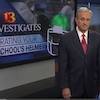One of the benefits of my job is that as I travel around the country working with TV stations, I see story ideas that spread like kudzu from one market to the next. One station in one city finds some success with the story, others hear about it, copy the idea and localize it. I find most of these cut and paste ideas pop up around “sweeps” months and most are awful. Here’s one that isn’t. It is worth looking at where you are and it may keep some kid from getting hurt.
In May, WDIV in Detroit began investigating high school football helmet safety. The station found that local high schools routinely issued players helmets that helmet safety experts said didn’t provide enough protection.
They used information from a rating system developed at Virginia Tech that assesses the safety of different football helmets. WDIV found that in Wayne County alone (Detroit), 13 schools are using the 1-star rated helmets. The station said nearly one-fourth of the helmets being used by high school players in Detroit Public Schools are One-Star or Two-Star helmets.
WISH-TV in Indianapolis also took up the helmet story. The station pointed out there is no manufacturer’s rating for helmet safety and produced stories saying youth helmets are often too heavy. Like WDIV, the station posted survey results from seven local school systems about what helmets they issued. As a result of WISH’s reporting, state officials will require schools to report concussions starting this month.
More recently, WTHR in Indianapolis pushed the story further. While teaching at a workshop for Dispatch Broadcasting stations recently, I heard about WTHR’s survey of 160 Indiana schools. The station filed more than 100 open records requests to produce an interactive map of the makes and models of 12,000 football helmets in use by high school and middle school players across the station’s viewing area. Three months later the station is still battling some school systems for the records. The station found hundreds of helmets in use that experts say offer little protection against concussions.
“Since 2011, the Virginia Tech studies of football helmets have shown that some of the most popular models of football helmets gave marginal protection against concussions,” said Bob Segall, investigative reporter. Many programs, including the NFL, used the information to quickly move to more protective models. But we found that for a range of reasons, high school and middle school programs didn’t move as fast.”
Once WTHR had its extensive database, the station contacted schools to let them know they were using helmets that were low rated. “This was a way to educate schools, parents and players,” Segall said. “In lots of cases we discovered the schools and coaches just were not aware that the helmets they were using were not the best choices. When we told them, the majority switched away or plan to quickly.”
Get Local-How Big is the Problem?
Segall tells me Indiana does not keep records of how many players suffer concussions, but the stations that have done these stories have all reported anecdotal evidence that the problem is worse at the high school level than even for college players. A 2013 study published by the Institutes of Medicine said high school football players suffered 11.2 concussions for every 10,000 games and practices. Among college players, the rate stood at 6.3. But the study raised questions about whether any helmet goes far enough to prevent concussions. Segall said coaches are beginning to stress safer blocking and tackling techniques that prevent injuries.
In some states, schools do not limit the number of players on a team. So in Indiana, a football team could have 100 players dressed out in uniforms. Virginia Tech experts said any school that cannot afford the most protective helmets should not put players on the field.
The Virginia Tech / Wake Forest School of Biomedical Engineering and Sciences website lists the 2014 helmet ratings. You will notice that there is little difference in cost between lower rated helmets and the highest rated ones.
Virginia Tech lists frequently asked questions about helmets, ratings and injuries.
But the story doesn’t end there. Segall told me that soon, researchers hope to have test results and ratings on other helmets including those used in baseball, lacrosse and hockey.
Even though other news outlets in other cities have done these stories, the journalists found the information is not getting to the people who need it most. It would be tempting to air stories about football helmet safety during football season, in the November ratings period for local TV. But these three stations didn’t wait. By airing and publishing stories before the new season begins, they may have prevented some athletes from suffering serious damage.







